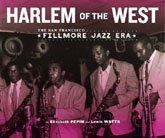 Harlem of the West: the San Francisco Fillmore Jazz Era
Harlem of the West: the San Francisco Fillmore Jazz EraBy Elizabeth Pepin and Lewis Watts
Chronicle Books
Tradepaper with extensive photos
0-8118-4548-6
The cover alone should convince readers of Harlem of the West: the San Francisco Fillmore Jazz Era's contention that an important time and place in the history of jazz was lost and nearly forgotten when city planners gutted the neighborhood. The first three musicians seen pictured from the left are John Handy, Pony Poindexter, and John Coltrane, sufficient evidence the Fillmore jazz scene was for real. Written by Elizabeth Pepin, with assistance from Lewis Watts, Harlem of the West is a well put together illustrated book that recaptures a forgotten chapter in jazz history.
In the 1940’s, 1950’s and 1960’s the Fillmore neighborhood of San Francisco was a thriving home to scores of jazz and blues clubs. Now the Fillmore Auditorium, transformed by Bill Graham into a legendary rock venue, is one of few surviving buildings from that era. Given Graham’s reputation, it might sound like exaggeration when Pepin writes:
“Most people only know about the Fillmore because of its auditorium, made famous by Bill Graham in the late 1960’s. Few are aware of its more important musical period in the decades preceeding.” (p. 13)
Yet, Pepin began her Fillmore research as an employee of Graham. The fact that clubs and establishments which hosted some of the finest jazz and blues entertainers could be so thoroughly removed from the neighborhood, and largely from memory, is a tragedy.
The photos collected in Harlem of the West, many recently discovered, are a time capsule from a different time. It was an era when people dressed up for a night on the town, and music was a major part of their plans. A number of great musicians, like Handy, Poindexter, Teddy Edwards, and Jerome Richardson, gigged in Fillmore clubs early in their careers, and there are wonderful images of them in this book.
There is a villain in Harlem of the West: the faceless bureaucrats who destroyed the neighborhood in the name of urban renewal. This is a book Justice Souter ought to read, as it makes clear the human price for eminent domain run amok.
John Handy told Pepin: “There wasn’t a Fillmore sound per say.” (p. 152) However, a tremendous about of excellent music was performed for appreciative audiences there. Sadly, that music was silenced by urban renewal policies, but Harlem of the West preserves the memories of that vibrant music scene.